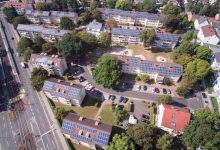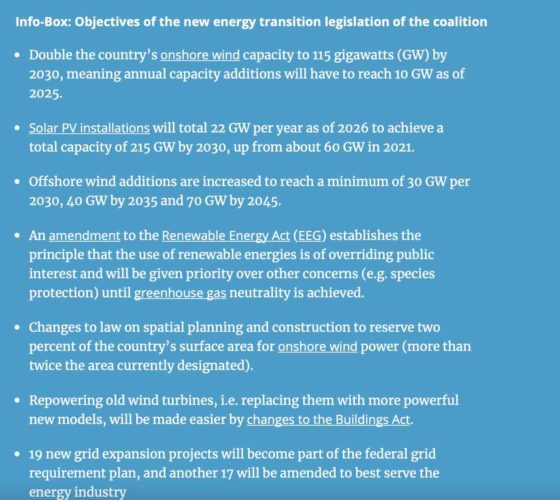Expanding renewable power generation capacity in Germany will become an overriding public interest, more space will be given to solar PV and wind power installations, and licensing and construction accelerated after the three-party coalition government reached a compromise on the largest energy transition package in years.
The coalition of Social Democrats (SPD), the Green Party and the pro-business Free Democrats (FDP) fought hard over details until a last-minute agreement on the over 20 laws and ordinances was reached on 5 July, just days before the parliamentary summer recess begins.
The draft of the energy reform package seen by Clean Energy Wire is designed to put Germany on track to climate neutrality by 2045 and wean it off Russian fossil fuels and will be voted on in parliament on 7 July.
“We are unleashing solar energy and ensuring enough areas for more wind turbines,” said Green Party parliamentary group’s vice chair Julia Verlinden. By 2030, the share of green electricity in the grid will be raised to 80 per cent, she stressed.
“Since the introduction of the Renewable Energy Act (EEG) in 2000, we have never made such a big step forward in the expansion of renewables,” said the Social Democrats (SPD) vice chair Matthias Miersch.
“With this comprehensive package, we are creating the basis for a climate-neutral energy supply in Germany,” he added.
Greenhouse-gas neutrality “after completion of the coal phase-out”
While the government’s proposed target of reaching a share of 80 per cent renewables in gross power consumption by 2030 remained in place, parliamentarians from the three-party ruling coalition scrapped the goal of a near 100 per cent greenhouse-gas neutral grid by 2035, as the pro-business and generally less climate-target enthusiastic FDP denied its consent.
Instead, the amended bill now states that greenhouse-gas neutrality of the power supply is aimed for “after the completion of the coal exit”.
The coal exit is officially scheduled for the year 2038 but the three-party government said in its 2021 coalition agreement that it would “ideally” bring this forward to 2030, a date that is now also pursued by coal mining states such as North Rhine-Westphalia and that has not been contested despite the fossil fuel shortage because of the Russian war against Ukraine.
However, leaders at last week’s G7 summit agreed to decarbonise their power systems by 2035, indicating that the German government’s overall goal of a 100-percent renewable grid in the middle of the 2030s has not changed.
After the coal exit, the funding for renewables shall be market driven, which is why there are no further renewable tender volumes or auction dates given. By the end of March 2024, the government is tasked with presenting a proposal of how renewable energy expansion can be financed after the completion of the coal phase-out.
The Green Party’s spokesperson and negotiator for climate action and energy in parliament, Ingrid Nestle, said the package contained several compromises.
“We Greens have fought to make the supply of renewable energy more cost-effective. But, for example, contracts for difference for offshore wind energy or a favourable concept for tenant electricity did not get majority support.”
More favourable rules for renewables
Instead, there will be “contracts for industry” – a special electricity price for industrial consumers that is to provide energy intensive companies with sufficient renewable electricity.
In some areas, parliamentarians created more favourable rules for renewables – for example by giving more space to solar PV installations next to motorways and to floating PV installations on lakes, and by permitting agri-PV installations also on permanent grassland (if not otherwise protected).
Solar industry association BSW said the EEG 2023 is an important first step, but the government now need to tackle investment barriers for PV operators by creating a better regulatory framework and cutting red tape.
The government-proposed expansion targets for the various renewable technologies remained untouched, meaning that tender volumes will be geared to achieving a doubling of the country’s onshore wind capacity to 115 gigawatts (GW) and 215 GW of solar PV as well as 30 GW of offshore wind capacity by 2030.
There will be a higher auction volume for so called “innovation tenders”, to incentivise the construction of more energy storage facilities. For the first time, there are going to be tender volumes for green hydrogen. In 2023, some 800 megawatt (MW) will be auctioned, followed by 200 MW annually until 2026.
States get more time to reach wind capacity targets
The FDP fought to keep the funding for small hydropower installations alive, Tagesspiegel Background reports, and the states won more time in achieving the target of using two percent of their land surface for onshore wind energy.
The 13 larger states need to designate 1.4 percent of their surface area to onshore wind power by 2027 – one year later than in the government’s draft law.
By 2032 they have to reach their respective targets of 1.8 to 2.2 percent; they are permitted to swap up to 50 percent (government proposal: 35%) of the areas between each other, enabling deals where states with little onshore capacity can pay states that overachieve their target.











